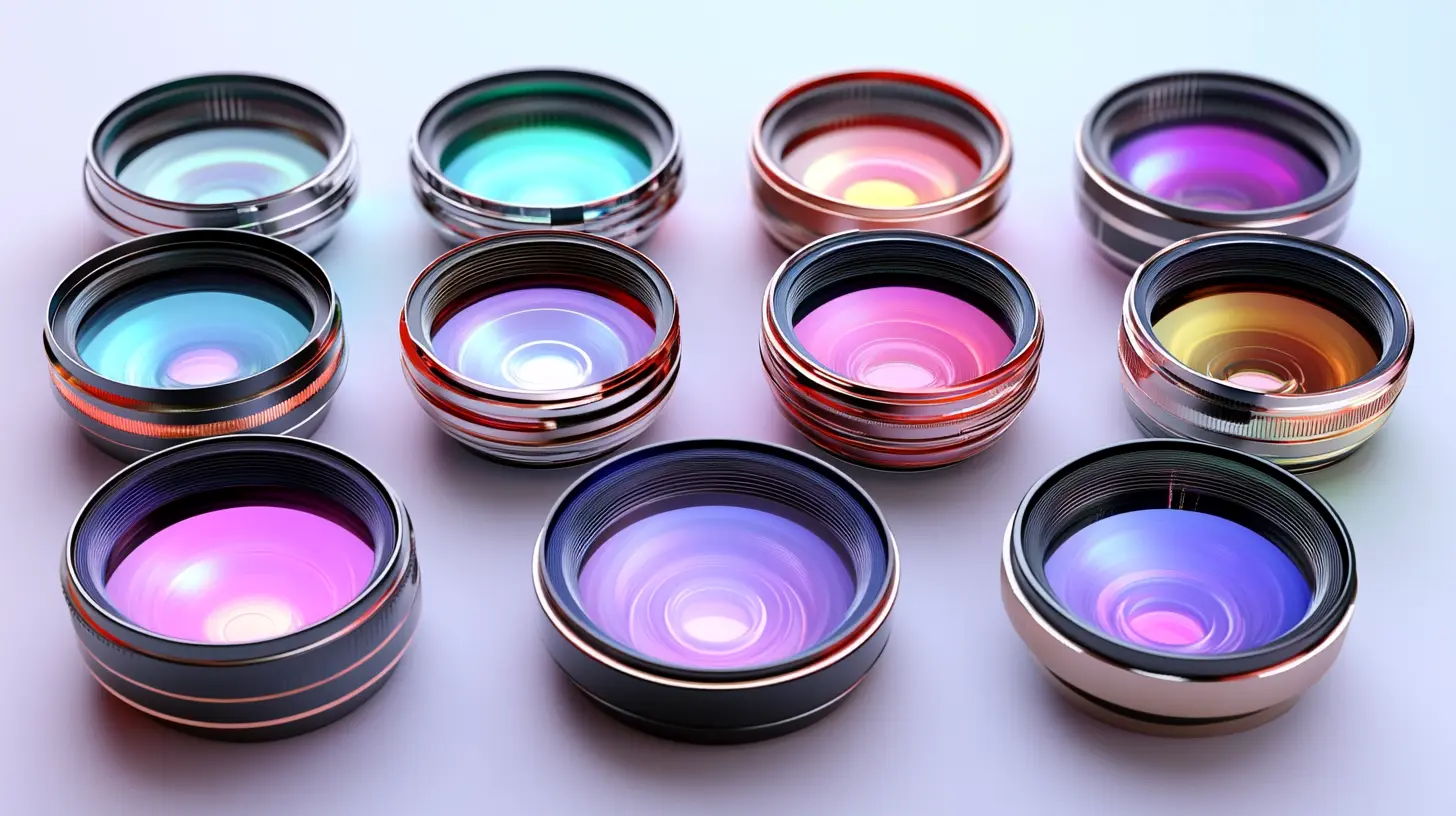The optical lenses market is ripe for transformation, with designs that could become fully operational by 2025 to change global procurement processes. The optical lenses market is projected to reach USD 30 billion by 2025, according to a recent report by ResearchAndMarkets, with lens advancements and rising consumer demand for specialized eyewear fuelling demand. With digital devices aplenty, the need for high-quality optical lenses, especially those produced by JINRUISHI Optical Glasses Co., Ltd., for instance, CR39 sunglasses lenses, CR39 polarized lenses, blue light blocking lenses, is felt as never before among consumers.
In this blog, we will look at seven innovative optical lens designs poised to alter the industry's terrain. As consumer preferences trend toward more personalized and functional designs, innovation in fields from photochromic lenses to special-purpose lenses is where JINRUISHI Optical Glasses sets the pace. In an age where sustainability and performance make or break a purchase, understanding these upcoming trends is vital to any stakeholder in the optical lenses market. Therefore, let's review some trends that will claim a stake in defining optical lenses into 2025 and beyond.

The year 2023 has become a crucial time concerning lens development, as new materials are being integrated for potentially revolutionary production changes. New developments in polymer science and glass formulation allow the manufacture of lenses that are increasingly thinner, lighter, and resistant to damage. These improvements therefore increase optical performance, in addition to enabling better procurement strategies for manufacturers. The news of a more important company in the optical lens sector signifies that the new-age material trend continues to gather momentum. As research and development continue, therefore, the upper hand lies with the advanced materials, high-index plastics, and green glass substitutes. Such innovation is leading to the production of lenses that are functional, with growing consumer preferences for sustainable and lightweight products. Further, the entire market being projected for massive growth, innovative materials will play an even more important role. Smart coatings and anti-reflective treatments are the revolutionary changes to lens performance, enabling versatility in application, ranging from photography to industrial use. All of these trends signal some transformation in the optical industry as future lens production is shaped by the innovative materials.

The optical lenses market is beginning a revolutionary change in the year 2025, as technological advancements dictate change. At the forefront of this change are smart optical lenses, bringing in new-age technology to improve vision and experience. According to a new study by Grand View Research, the global smart glasses market has been estimated to reach approximately $5.5 billion by 2025, exhibiting a CAGR of 34.9%. Such high growth implies a rising demand for lenses that do more than proper vision but also serve other functions.
The integration of augmented reality (AR) and virtual reality (VR) features is one of the major trends driving the optical lenses market forward. Companies are developing smart lenses with display integration so that the wearer can see and assimilate information hands-free whilst navigating through life. For example, vVARDIS and Mojo Vision smart lenses provide real-time data overlays to enhance the situational awareness of the wearer. MarketsandMarketssays that this will contribute to the growth of the AR space alone, which could reach $198 billion by 2025. This then cementing the position of smart lenses in a host of other industries, including healthcare, retail, and education.
Furthermore, scientific advances are increasingly giving rise to lenses designed to adapt their properties automatically to environmental conditions. In particular, photochromic lenses that darken in sunlight and clear indoors are gaining momentum. A report by Transparency Market Research estimated that the global market for photochromic lenses would grow at a CAGR of 5.2% for 2020-2027. Thus, such a confluence of technology and innovation heralds the evolution of a new era of functional lenses that offer enhancement to lifestyle and are, thus, paving the road for the future of vision correction.

From being the latest information on training as it stands until October 2023, sustainability in optical lenses has attracted sharp attention from both manufacturers and consumers. With the changing times, adoption of environmentally conscious and eco-friendly manufacturing practices has also brought about newer innovations in designs that improve optical performance and reduce environmental postural impact. Trends in optical lenses for 2025 are totally indicative of the change happening in the optical lens manufacture, with manufacturers bringing that green into the light of their raw materials using new technologies.
A primary example is the increasingly popular approach to using recycled materials in lens fabrication. This reduces wastage and also significantly decreases the items' carbon footprint for raw material procurement. Companies invest in energy-efficient manufacturing that will reduce energy consumed and, therefore, lower emissions from production. The industry is thus taking on more of these practices. Consumers will, however, increasingly flock to such brands as those whose products prioritize sustainable practices.
Sustaining the New Freshness in Optical Lenses is significantly raising the bar for quality and innovation. As brands revise their supply chains and methods of production, a considerable amount of thrust will go into building longer-lasting lenses that perform better but keep a close eye on the ecological footprint they leave behind. The advances in lens technology combined with sustainable practices will not only satisfy the senses of those demanding environmentally responsible products, but will also keep the companies in good stead for survival in the highly competitive world marketplace.

It denotes the optical usage lenses market entering a new phase in the life as it is considered to grow from $21.08 billion by the year 2025 to $39.58 billion by the year 2032, thus achieving 8.8% compound annual growth. This increase is highly attributed to the advancement in customizing, enabling the manufacturers to produce optical lenses according to various individual needs and requirements. As advancements in technology continue, there is a common scenario where consumers will demand more custom-made lenses which not only serve their main purposes-whether photography, virtual reality, or even assisting everyday vision correction-but also satisfy personal needs.
New trends point to high-resolution lenses, optical stabilization, and optical zoom features as largely influenced by the biting competition among all smartphone manufacturers. Customization of these optical solutions for inclusion in consumer electronics reinforces the necessity for lens designs to be innovative. The fight to patent after investing in research and development signifies the degree to which proprietary technology will go to provide differentiation in the products in a very cluttered marketplace.
Likewise, innovative optical technologies are to enhance their performance in devices across the smart home and more consumer electronics. It would not have been surprising to see the trend towards providing personalized lenses, as today`s consumer wants not only something to meet a basic necessity but prefers customizing for its very own usefulness, making way for yet a new era of optics personal technology.
Demand for optical lenses is likely to keep on changing, while the rise of multifocal designs is set to become the leading trend in the year 2025. These new lenses have been designed to adapt to a very broad spectrum of vision-related needs, indicating the rising demand for such personalized solutions in a worldview filled with visual clarity requirements. Multifocal lenses do not constitute just a solution for presbyopia; they instead offer combinations of prescriptions within a single lens, hence providing seamless transitions between different visual tasks-whether reading, computer work, or any outdoor activity.
The impact of modern advances in the optical industry indicates their importance of being adapted in design; thereby, manufacturers keep-on staying ahead of consumer demands to satisfy so-called urgent expectations. Investments are being funneled into new technologies and materials that promise enhanced functionality and user comfort with the use of multifocal lenses. The optics industry is thereby showing further growth owing to huge investments, such as the 10 billion revenue milestone expected from the ramping up of camera-centric startups, thus assuring a healthy growth program for the optical industry.
In a scenario where advanced methods of manufacture and digital optics come together, the very notion of how a multifocal lens is rendered will undergo revolution, resulting in personalized designs suited to the subjective vision needs of an individual. It's quite some time before we can see lenses being transformed-most lined up to aesthetic adaptation and performance improvements, therefore enhancing consumer experience from one corner of the Earth to the other.
Operating from a perspective that looks at the horizon of the optical technology world, AR lenses are easing the blending of the digital with the physical. Such advanced lenses are not merely objects for vision correction, they act as harbingers of a modifying way of taking on the world. The AR lenses, by overlaying digital information on the real world, enhance perception to give an imaginary, interactive experience from the mundane.
You can stroll through your city, receiving real-time information about restaurants, historical sites, and traffic conditions, all within your line of sight. It is exactly that: AR lenses will use algorithms as well as sensors to furnish contextual information that is responsive to the needs of the user. Therefore, this ability also empowers humans, but it also primes businesses to establish new dynamics in connecting with consumers, transforming retail and marketing paradigms.
Generally, while it all seems to concentrate on consumerism, AR lenses have even wider applications. By giving professionals AR overlay capabilities, these lenses will enhance precision and efficiency in various fields such as medicine, education, and manufacturing. Surgeons see critical internal structures as they operate, while students learn through immersive experiences that cultivate a greater understanding of complex subjects. Farther on the horizon, AR lenses will continue to challenge our conception of reality, never before merging the digital expanse with our physical world like now, as we approach the year 2025.
The lens within optical lenses is going through great change because of the innovation around the global supply chain within the optical lens industry. The current trend is a report by Transparency Market Research which shows that the optical lens industry will exceed a figure of USD 31.2 billion by the year 2025, driven by advancements like materials and mature manufacturing processes. Such improvements facilitate not only the quality of products but also procurement strategies for businesses across industries.
A major trend in distribution of optical lenses is digital supply chain management. By implementing IoT and blockchain technology today, companies can provide a higher level of transparency and traceability in the procurement process. Allied Market Research also has a report indicating that such a market shall reach USD billion 42.43 World's region for IoT in the supply chain by 2027-an opening opportunity for the optical lens maker to manage inventories in real-time as well as the entire logistics process. This is crucial in digitizing the way customized lens solutions are supplied, as it keeps the lead time at a minimum.
However, sustainability is increasingly becoming a consideration in the supply chain of optical lenses. As estimated by a study conducted by McKinsey & Company, two-thirds (66 percent) of consumers would pay more for sustainable products. That compels the manufacturers to adopt eco-friendly materials and processes. This change meets consumer needs, while at the same time, matching the international trend toward greener procurement standard. Sustainable practices strengthen companies' reputations while also developing a more responsible supply chain for the optical lens sector.
Emerging markets have an important role to play in directing the trends of optical lenses since their demand continues to grow at such an unprecedented pace. A recent Grand View Research report emphasized that the global optical lens market was valued at over $15 billion in 2022; this number is projected to increase at a CAGR of 6.3 percent from 2023 to 2030. By far, the highest driver for this significant growth is increasing demand for vision correction, particularly in India, Brazil, and other developing middle-income countries, where better purchasing power and health awareness continues to grow.
Besides, emerging markets undergo digital transformation and, at the same time, transform consumer expectations. With every day increasing penetration of smartphones and wearable technologies, consumers increasingly look for high-quality lenses with optical clarity plus such features as blue light blocking and anti-reflective coating. As per a report of IBISWorld, in 2021, more than 54% of lens sales in emerging markets were progressive and high-index lenses.
The manufactures have responded with huge investments in innovative designs that meet the ever-changing requirements. They are introducing adaptive lenses and personalized optical solutions unique to the regional consumer characteristics. Localized product development is important, as seen in Asian markets; for example, popularity has arisen in photochromics due to increased outdoor lifestyles by younger populations. The orientation with local consumer preference is very relevant for companies willing to tap into this dynamic growth in these areas.
Multifocal lenses cater to diverse vision requirements, addressing presbyopia and integrating multiple prescriptions into a single lens for smooth transitions between different visual tasks.
Manufacturers are investing in new technologies and materials to enhance the functionality and comfort of multifocal lenses, emphasizing adaptability in their designs.
The optics sector is experiencing substantial investments, with camera-centric startups anticipated to reach a revenue milestone of 10 billion, indicating robust growth in optical technology.
Advanced manufacturing processes and digital optics are redefining the production of multifocal lenses, leading to tailored designs that meet individual vision needs.
AR lenses are set to seamlessly integrate digital information with the physical world, transforming how we interact with our environment and enhancing sensory perception.
AR lenses can display real-time information about restaurants, historical landmarks, or traffic conditions within the user’s line of sight while they navigate through their city.
In healthcare, education, and manufacturing, AR lenses can enhance precision and efficiency, such as allowing surgeons to visualize internal structures or providing immersive learning environments for students.
AR lenses create new opportunities for businesses to engage customers dynamically, revolutionizing retail and marketing strategies by delivering contextual data tailored to user needs.
As the evolution of multifocal and AR lenses unfolds, we can expect shifts in both the aesthetics and performance, enhancing user experiences and incorporating more personalized solutions.


